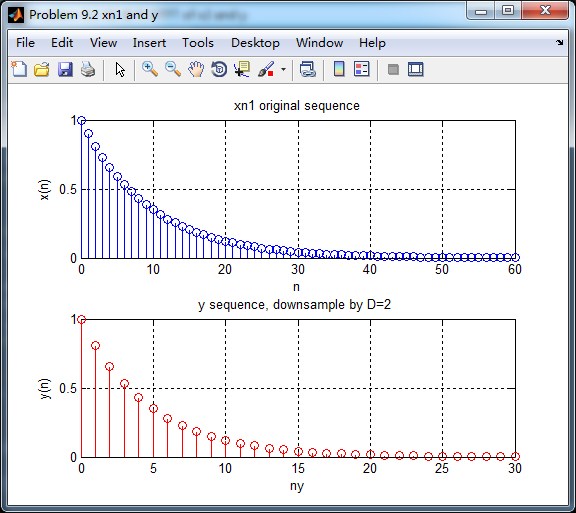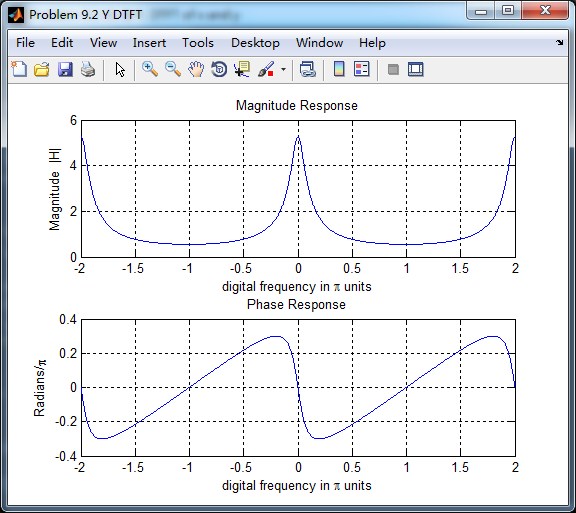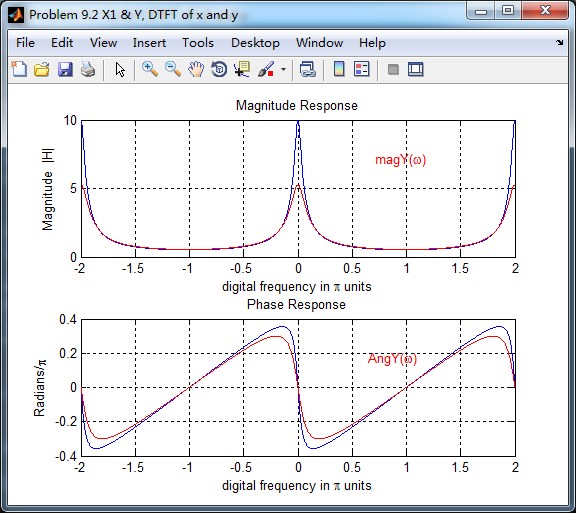《DSP using MATLAB》Problem 9.2
前几天看了看博客,从16年底到现在,3年了,终于看书到第9章了。都怪自己愚钝不堪,唯有吃苦努力,一点一点一页一页慢慢啃了。

代码:
%% ------------------------------------------------------------------------
%% Output Info about this m-file
fprintf('\n***********************************************************\n');
fprintf(' <DSP using MATLAB> Problem 9.2 \n\n'); banner();
%% ------------------------------------------------------------------------ % ------------------------------------------------------------
% PART 1
% ------------------------------------------------------------ % Discrete time signal n1_start = 0; n1_end = 60;
n1 = [n1_start:1:n1_end]; xn1 = (0.9).^n1 .* stepseq(0, n1_start, n1_end); % digital signal D = 2; % downsample by factor D
y = downsample(xn1, D);
ny = [n1_start:n1_end/D]; figure('NumberTitle', 'off', 'Name', 'Problem 9.2 xn1 and y')
set(gcf,'Color','white');
subplot(2,1,1); stem(n1, xn1, 'b');
xlabel('n'); ylabel('x(n)');
title('xn1 original sequence'); grid on;
subplot(2,1,2); stem(ny, y, 'r');
xlabel('ny'); ylabel('y(n)');
title('y sequence, downsample by D=2 '); grid on; % ----------------------------
% DTFT of xn1
% ----------------------------
M = 500;
[X1, w] = dtft1(xn1, n1, M); magX1 = abs(X1); angX1 = angle(X1); realX1 = real(X1); imagX1 = imag(X1); %% --------------------------------------------------------------------
%% START X(w)'s mag ang real imag
%% --------------------------------------------------------------------
figure('NumberTitle', 'off', 'Name', 'Problem 9.2 X1 DTFT');
set(gcf,'Color','white');
subplot(2,1,1); plot(w/pi,magX1); grid on; %axis([-1,1,0,1.05]);
title('Magnitude Response');
xlabel('digital frequency in \pi units'); ylabel('Magnitude |H|');
subplot(2,1,2); plot(w/pi, angX1/pi); grid on; %axis([-1,1,-1.05,1.05]);
title('Phase Response');
xlabel('digital frequency in \pi units'); ylabel('Radians/\pi'); figure('NumberTitle', 'off', 'Name', 'Problem 9.2 X1 DTFT');
set(gcf,'Color','white');
subplot(2,1,1); plot(w/pi, realX1); grid on;
title('Real Part');
xlabel('digital frequency in \pi units'); ylabel('Real');
subplot(2,1,2); plot(w/pi, imagX1); grid on;
title('Imaginary Part');
xlabel('digital frequency in \pi units'); ylabel('Imaginary');
%% -------------------------------------------------------------------
%% END X's mag ang real imag
%% ------------------------------------------------------------------- % ----------------------------
% DTFT of y
% ----------------------------
M = 500;
[Y, w] = dtft1(y, ny, M); magY_DTFT = abs(Y); angY_DTFT = angle(Y); realY_DTFT = real(Y); imagY_DTFT = imag(Y); %% --------------------------------------------------------------------
%% START Y(w)'s mag ang real imag
%% --------------------------------------------------------------------
figure('NumberTitle', 'off', 'Name', 'Problem 9.2 Y DTFT');
set(gcf,'Color','white');
subplot(2,1,1); plot(w/pi, magY_DTFT); grid on; %axis([-1,1,0,1.05]);
title('Magnitude Response');
xlabel('digital frequency in \pi units'); ylabel('Magnitude |H|');
subplot(2,1,2); plot(w/pi, angY_DTFT/pi); grid on; %axis([-1,1,-1.05,1.05]);
title('Phase Response');
xlabel('digital frequency in \pi units'); ylabel('Radians/\pi'); figure('NumberTitle', 'off', 'Name', 'Problem 9.2 Y DTFT');
set(gcf,'Color','white');
subplot(2,1,1); plot(w/pi, realY_DTFT); grid on;
title('Real Part');
xlabel('digital frequency in \pi units'); ylabel('Real');
subplot(2,1,2); plot(w/pi, imagY_DTFT); grid on;
title('Imaginary Part');
xlabel('digital frequency in \pi units'); ylabel('Imaginary');
%% -------------------------------------------------------------------
%% END Y's mag ang real imag
%% ------------------------------------------------------------------- figure('NumberTitle', 'off', 'Name', 'Problem 9.2 X1 & Y, DTFT of x and y');
set(gcf,'Color','white');
subplot(2,1,1); plot(w/pi,magX1); grid on; %axis([-1,1,0,1.05]);
title('Magnitude Response');
xlabel('digital frequency in \pi units'); ylabel('Magnitude |H|');
hold on;
plot(w/pi, magY_DTFT, 'r'); gtext('magY(\omega)', 'Color', 'r');
hold off; subplot(2,1,2); plot(w/pi, angX1/pi); grid on; %axis([-1,1,-1.05,1.05]);
title('Phase Response');
xlabel('digital frequency in \pi units'); ylabel('Radians/\pi');
hold on;
plot(w/pi, angY_DTFT/pi, 'r'); gtext('AngY(\omega)', 'Color', 'r');
hold off;
运行结果:
原始序列x和按D=2抽取后序列y,如下

原始序列x的DTFT,这里只放幅度谱和相位谱,DTFT的实部和虚部的图不放了(代码中有计算)。

抽取后序列y的DTFT如下图,也是幅度谱和相位谱,实部和虚部的图不放了(代码中有计算)。

将上述两张图叠合到一起做对比,红色曲线是抽取后序列的DTFT,蓝色曲线是原始序列的DTFT。
可见,红色曲线的幅度近似为蓝色曲线的二分之一(1/D,这里D=2)。

《DSP using MATLAB》Problem 9.2的更多相关文章
- 《DSP using MATLAB》Problem 7.27
代码: %% ++++++++++++++++++++++++++++++++++++++++++++++++++++++++++++++++++++++++++++++++ %% Output In ...
- 《DSP using MATLAB》Problem 7.26
注意:高通的线性相位FIR滤波器,不能是第2类,所以其长度必须为奇数.这里取M=31,过渡带里采样值抄书上的. 代码: %% +++++++++++++++++++++++++++++++++++++ ...
- 《DSP using MATLAB》Problem 7.25
代码: %% ++++++++++++++++++++++++++++++++++++++++++++++++++++++++++++++++++++++++++++++++ %% Output In ...
- 《DSP using MATLAB》Problem 7.24
又到清明时节,…… 注意:带阻滤波器不能用第2类线性相位滤波器实现,我们采用第1类,长度为基数,选M=61 代码: %% +++++++++++++++++++++++++++++++++++++++ ...
- 《DSP using MATLAB》Problem 7.23
%% ++++++++++++++++++++++++++++++++++++++++++++++++++++++++++++++++++++++++++++++++ %% Output Info a ...
- 《DSP using MATLAB》Problem 7.16
使用一种固定窗函数法设计带通滤波器. 代码: %% ++++++++++++++++++++++++++++++++++++++++++++++++++++++++++++++++++++++++++ ...
- 《DSP using MATLAB》Problem 7.15
用Kaiser窗方法设计一个台阶状滤波器. 代码: %% +++++++++++++++++++++++++++++++++++++++++++++++++++++++++++++++++++++++ ...
- 《DSP using MATLAB》Problem 7.14
代码: %% ++++++++++++++++++++++++++++++++++++++++++++++++++++++++++++++++++++++++++++++++ %% Output In ...
- 《DSP using MATLAB》Problem 7.13
代码: %% ++++++++++++++++++++++++++++++++++++++++++++++++++++++++++++++++++++++++++++++++ %% Output In ...
- 《DSP using MATLAB》Problem 7.12
阻带衰减50dB,我们选Hamming窗 代码: %% ++++++++++++++++++++++++++++++++++++++++++++++++++++++++++++++++++++++++ ...
随机推荐
- 找关键字,分割字符串,输出一个vector
vector<string> split(const string& str, const string& delim) { vector<string> re ...
- 前台页面中json和字符串相互转化
比如我有两个变量,我要将a转换成字符串,将b转换成JSON对象: var a={"name":"tom","sex":"男&quo ...
- 关闭windows的DEP
1.与开启dep时一样,按组合键win+r打开运行窗口,输入cmd并按回车,如图所示: 2.调出命令提示符窗口后,输入bcdedit.exe/set {current} nx AlwaysOff ...
- input checkbox 禁止选中/修改
input checkbox 禁止选中 <input type="checkbox" onclick="return false;" /> inp ...
- Linux的命名空间
1. 为什么提供命名空间 命名空间是一种轻量级的虚拟化手段. 传统的虚拟化软件,是虚拟化多个不同的操作系统,对共享资源的限制很大. 通过提供命名空间,可以让进程与进程之间,用户与用户之间彼此看不到对方 ...
- Kibana < 6.6.1 代码执行漏洞复现CVE-2019-7609
登陆kibana poc .es(*).props(label.__proto__.env.AAAA='require("child_process").exec("ba ...
- Day 21 python :面向对象 类的相关内置函数 /单例模式 /描述符
1.isinstance(obj,cls) 检查obj是否是类cls的对象: 备注:用isinstance 的时候,产生实例后,会显示实例既是父类的实例,也是子类的实例 class Mom: gend ...
- MySql 主从复制及深入了解
分享一个不错的mysql文章 https://segmentfault.com/a/1190000008942618
- CM集群管理
用CM装完cdh 版本后,将不同机架的服务器已经认为拆掉网线,但是主机管理那边还是显示已经下载的服务器存在. 如图: 该怎么配置 node8 和node9会自动消失: DataNode已经显示 ...
- 关于Swagger @ApiModel 返回内容注释不显示问题
今天做了一天@ApiModel希望Swagger生成的文档出现返回的内容注释,发现需要用到@ApiModel注解到你需要返回的类上 @ApiModelProperty作为字段的描述 例如 之后文档还 ...
